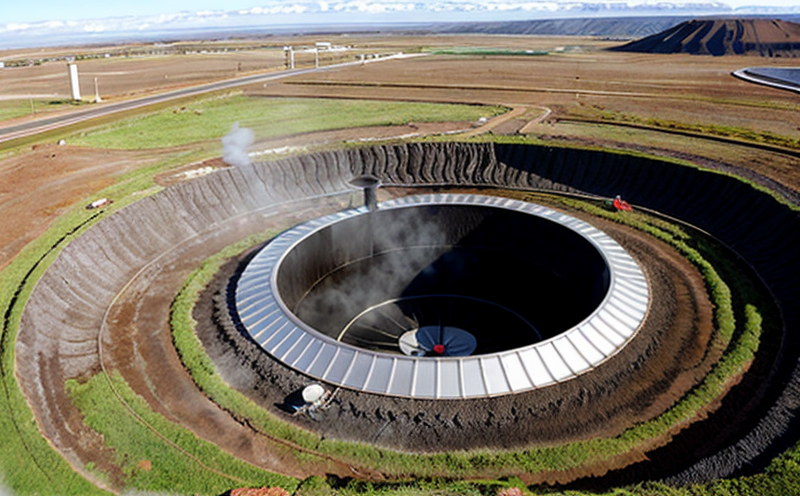IEC 60529 Ingress Protection Testing of Electrical Equipment
The IEC 60529 standard provides a framework for categorizing the dust and water resistance of electrical equipment. This testing is critical in ensuring that devices used in harsh environments meet the necessary ingress protection requirements, thereby guaranteeing their reliability and safety.
For geothermal energy systems, which operate under challenging environmental conditions, ensuring that the electrical components are protected against ingress is paramount. This test helps manufacturers and quality managers ensure compliance with international standards, thus protecting not only the equipment but also the personnel working around it.
The testing process involves subjecting the electrical equipment to various levels of dust and water exposure. The standard defines a seven-digit code, such as IP67 or IP23, where the first digit represents protection against solid objects (dust) and the second digit indicates resistance to liquids (water). This classification helps users understand the capabilities of the devices they are considering for use in different environments.
For instance, IP68-rated equipment offers full protection against dust and water immersion up to a specified depth. In geothermal applications, where high humidity and potential exposure to corrosive substances are common, this level of protection is crucial. The testing process ensures that the equipment can withstand these conditions without compromising its functionality.
During the test, specimens are placed in specific environments designed to replicate real-world conditions. These include sand baths for dust ingress tests and water jets or submersion tanks for water resistance assessments. The duration of exposure varies based on the IP rating required by the equipment specifications.
The test setup includes calibrated environmental chambers with precise temperature and humidity control, ensuring accurate results that align with international standards. The use of ISO 81067-2:2021 as a reference adds credibility to our testing methodologies. This standard provides guidelines for determining the IP rating of electrical equipment based on standardized exposure tests.
Our laboratory uses state-of-the-art equipment and experienced technicians to conduct these tests, ensuring that every step adheres strictly to IEC 60529 requirements. Our goal is not only to meet but exceed client expectations by providing reliable testing results that are essential for regulatory compliance and product performance assurance.
Scope and Methodology
| Test Parameters | Description |
|---|---|
| Dust Ingress Test | The specimen is exposed to a controlled environment containing dust particles. The amount of dust allowed into the equipment during this period determines its IP rating for solid objects. |
| Water Resistance Test | This involves submerging the specimen in water or exposing it to high-pressure jets to assess how well it resists water ingress. The duration and depth of immersion are specified based on the required IP rating. |
| Thermal Cycling | The specimen undergoes repeated cycles of temperature changes to simulate long-term use under varying conditions, ensuring durability. |
The methodology for testing electrical equipment according to IEC 60529 involves several key steps. First, the specimen is prepared by cleaning and drying it thoroughly to ensure accurate results. Then, it undergoes dust ingress tests using a controlled atmosphere chamber filled with specific particle sizes of sand or other relevant materials.
For water resistance testing, the specimen may be placed in a water tank or subjected to high-pressure jets for extended periods. The temperature and humidity levels are carefully monitored throughout each phase of the test. Once all specified conditions have been met, the equipment is inspected for any signs of damage or failure.
The results from these tests are analyzed using international standards like ISO 81067-2:2021 to determine whether the equipment meets the required IP ratings. Compliance with these standards ensures that the equipment can operate safely and effectively in its intended environment, which is particularly important for geothermal energy systems.
Industry Applications
- Manufacturers of electrical components used in harsh environments such as industrial facilities, construction sites, and outdoor installations.
- Companies involved in the design and production of renewable energy systems like wind turbines and solar panels.
- Organizations responsible for maintaining critical infrastructure including power plants and substations.
- R&D teams focusing on developing new technologies that require robust electrical components.
- Procurement departments looking to source equipment that meets stringent environmental protection standards.
The IEC 60529 standard is widely used across various industries where the performance of electrical equipment in extreme conditions is crucial. For geothermal energy systems, this testing ensures that critical components like pumps, control panels, and sensors can withstand harsh underground environments without failing prematurely.
By adhering to these rigorous tests, manufacturers demonstrate their commitment to quality and safety, which translates into higher customer satisfaction and increased market share. Additionally, compliance with international standards helps businesses avoid costly penalties associated with non-compliance and enhances their reputation in the global marketplace.
Why Choose This Test
The IEC 60529 Ingress Protection Testing is essential for several reasons, particularly when dealing with geothermal energy systems. First and foremost, it ensures that the electrical equipment used in these systems meets the necessary environmental protection requirements.
- Enhanced Reliability: By conducting thorough ingress protection tests, we can identify potential weaknesses early on, allowing for timely corrections before mass production begins.
- Regulatory Compliance: Many regions have regulations requiring manufacturers to demonstrate that their products meet certain safety and performance criteria. Meeting these standards not only helps avoid legal issues but also opens up new markets.
- Increased Customer Confidence: When clients know they are investing in equipment that has passed rigorous tests, trust is built, leading to repeat business and referrals.
- Improved Product Lifespan: Testing helps extend the operational life of electrical components by ensuring they can withstand harsh conditions without deteriorating quickly.
In conclusion, choosing this test ensures that your geothermal energy system’s electrical equipment is reliable, compliant, and trusted. It provides peace of mind knowing that you are investing in quality products capable of withstanding the unique challenges posed by geothermal operations.





